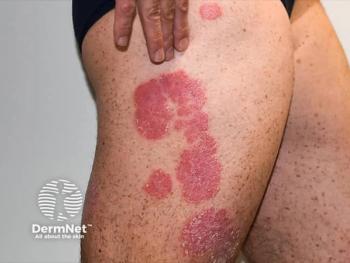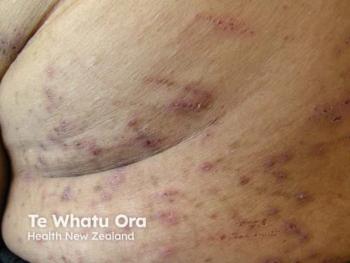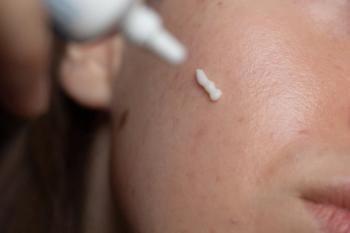
- Dermatology Times, May 2025 (Vol. 46. No. 05)
- Volume 46
- Issue 05
Topical Steroid Withdrawal: Uncovering Neuroinflammatory Mechanisms
Key Takeaways
- TSW may be a distinct dermatologic condition, supported by neuroinflammatory molecular evidence, challenging assumptions of it being merely a flare of atopic dermatitis.
- Molecular analyses reveal neuroinflammation in TSW-affected skin, with increased NAD+ activity, suggesting mitochondrial complex I inhibitors as potential therapeutic options.
Our May cover story explores NIH’s new findings on topical steroid withdrawal, a condition now under scientific scrutiny as a distinct entity.
The controversy surrounding the use of corticosteroids and topical steroid withdrawal (TSW) syndrome has recently piqued the interest of research teams within the National Institutes of Health (NIH)’s National Institute of Allergy and Infectious Diseases, prompting a scientific investigation into whether TSW constitutes a distinct dermatologic condition with unique cutaneous features.
Topical corticosteroids remain the first-line treatment for chronic inflammatory conditions such as atopic dermatitis, which affects 10% to 20% of pediatric dermatology patients and 2% to 10% of adults.1 Research has highlighted the impact of unmanaged atopic dermatitis, particularly in children, showing an association with behavioral concerns.2 This is largely due to sleep disturbances that can hinder development, underscoring the importance of proper management.3
Although topical corticosteroids are among the few evidence-based treatments for chronic inflammatory conditions such as atopic dermatitis, many patients hesitate to use them.4 In some cases, patients and health care providers have reported cases of TSW, also known as red skin syndrome or steroid-induced dermatitis, following cessation of high-dose and prolonged corticosteroid use.5 Although no standardized diagnostic criteria exist, TSW is characterized by tachyphylaxis and skin barrier disruption, leading to skin irritation, thermal dysregulation, and pruritus in previously treated and untreated areas of the skin.6
Using cultured skin and mouse models, researchers at the NIH conducted molecular analyses employing advanced techniques such as transcriptomics and metabolomics.7 These investigations revealed activation of neuroinflammation in TSW-affected skin.8 Notably, increased activity of nicotinamide adenine dinucleotide (NAD+), a vitamin B3-derived coenzyme involved in mitochondrial complex I activity, was observed in response to corticosteroid use.8 These findings led to the exploration of mitochondrial complex I blockade as a potential therapeutic strategy. In a subsequent pilot study, participants with TSW were treated with complex I inhibiting agents, namely metformin and berberine. After 3 to 5 months of treatment, most reported meaningful improvement in their symptoms.
If validated by larger studies, these findings could have several implications for clinical practice, including the recognition of TSW as a distinct condition, enhancement of patient counseling and risk-benefit discussions, increased clinical monitoring, and the development of targeted treatment strategies.
TSW as a Distinct Condition
The neuroinflammatory molecular evidence supports that TSW may be biologically distinct from atopic dermatitis.9 This challenges the assumption that TSW symptoms may be merely a flare, laying the groundwork for formal diagnostic criteria in clinical settings.
Increased Monitoring for TSW
With a biological mechanism emerging through NAD+ pathways, dermatology clinicians may consider screening for signs of TSW in patients on long-term corticosteroids, especially if symptoms appear in untreated areas.
Counseling and Risk-Benefit Discussions
Clinicians may be better equipped to engage in informed discussions with patients about the potential risks of prolonged or high-potency corticosteroid use, given the biological basis for TSW. Understanding that neuroinflammatory changes may occur gives weight to patient-reported symptoms often interpreted as “steroid phobia.”10
Alternative Treatment Strategies
The pilot data demonstrating symptom improvement with mitochondrial complex I inhibitors, such as metformin and berberine, suggests potential therapeutic options for patients with TSW.11,12 Although preliminary, these findings may inform future adjunctive treatments or tapering protocols for patients who require higher corticosteroid use to manage chronic conditions. This research highlights the potential for developing alternative options for patients who experience challenges with traditional steroid treatments.
Diagnosing and Treating TSW
A joint statement issued by the National Eczema Society and the British Association of Dermatologists highlighted the physical and autonomic manifestations of TSW and its diagnostic challenges. The statement noted that patients may experience fatigue or malaise for months following steroid use, which can impact emotional well-being and lead to employment absenteeism. The National Eczema Society further emphasized the diagnostic challenges, pointing to the lack of evidence for a biologically driven connection that could serve as the impetus for developing diagnostic criteria. The complexity of diagnosis was further elucidated through clinical scenarios. For example, TSW often presents as dermatitis, making it difficult to distinguish from a recurrence of an inflammatory condition initially treated with topical steroids. Furthermore, steroids are known immunosuppressants that alter the skin’s barrier, impairing the response to infections and leading to clinical manifestations that can be mistaken for TSW.12 Other inflammatory conditions that present similarly include rosacea and forms of psoriasis.12
When addressing TSW and implementing treatments, research suggests that the primary approach should involve a transition to other anti-inflammatory agents or gradual tapering of the steroids. This is often compounded with therapies aimed at restoring and supporting the skin barrier, including the use of antibiotics, emollients, and hydrators to manage dryness and prevent secondary infections.13
A recent case report highlighted the resolution of TSW symptoms in a patient through the use of a JAK inhibitor, topical ruxolitinib (Opzelura; Incyte) 1.5% cream. This was after the patient experienced poor tolerance to the calcineurin inhibitors tacrolimus (Protopic; LEO Pharma) 0.1% ointment and pimecrolimus (Elidel; Novartis) 1% cream, indicating that ruxolitinib may offer an effective alternative in such cases.14 This case adds to growing evidence that targeted therapies can effectively manage TSW symptoms when conventional treatments are not well tolerated.
The recent NIH findings suggest that agents targeting NAD+, such as metformin and berberine, may play a role in addressing TSW. Metformin, a commonly used medication for type 2 diabetes, has been shown to activate AMP-activated protein kinase (AMPK), which in turn influences NAD+ metabolism.15 Berberine, an alkaloid found in several plants, also activates AMPK and has been demonstrated to modulate NAD+ levels, potentially supporting mitochondrial function.16 These agents, along with others, have been shown to influence NAD+ cellular levels, indicating potential therapeutic pathways for managing TSW. Some groups of direct and indirect pharmacological agents also influence cellular NAD+ levels, although their role in addressing TSW has not been identified. Direct modulators of NAD+ include rapamycin (an mTOR inhibitor), whereas indirect modulators include nicotinamide (a precursor that can impede NAD+ biosynthesis and consumption pathways), aspirin (which activates NAD+ consumption enzymes), and statins (which reduce NAD+ through their effects on CoQ10 production).17
Supporting Individuals Affected by TSW
Beyond pharmacological management, supporting individuals with TSW requires a multifaceted approach. Peer-led organizations such as the International Topical Steroid Awareness Network offer community support and advocacy. Patient and caregiver education on environmental triggers and skin-protective habits such as sunscreen, as well as when to seek medical care, is essential. Additionally, addressing the psychological burden through access to mental health resources is critical for comprehensive care.
Zeena Mestari is a third-year medical student at the UCLA David Geffen School of Medicine, dedicated to patient advocacy within pediatric dermatology. She is also a finalist for the UCLA Health Equity Challenge grant.
Bernard Cohen, MD, is an associate professor of pediatrics and dermatology at Johns Hopkins University School of Medicine in Baltimore, Maryland.
References
- Eczema stats. National Eczema Association. Accessed April 6, 2025.
https://nationaleczema.org/eczema-facts/ - Ma EZ, Hooper SR, Seegan PL, Wan J. Association of atopic dermatitis with emotional and behavioral problems in childhood. J Am Acad Dermatol. 2024;90(6):1249-1252. doi:10.1016/j.jaad.2024.01.068
- Camfferman D, Kennedy JD, Gold M, Martin AJ, Lushington K. Eczema and sleep and its relationship to daytime functioning in children. Sleep Med Rev. 2010;14(6):359-369. doi:10.1016/j.smrv.2010.01.004
- Maghen P, Unrue EL, Oussedik E, Cline A, Cardwell LA, Feldman SR. Regardless of how risks are framed, patients seem hesitant to use topical steroids for atopic dermatitis. Br J Dermatol. 2019;181(4):842-844. doi:10.1111/bjd.17929
- Brookes TS, Barlow R, Mohandas P, Bewley A. Topical steroid withdrawal: an emerging clinical problem. Clin Exp Dermatol. 2023;48(9):1007-1011. doi:10.1093/ced/llad161
- Mohta A, Sathe NC. Topical steroid withdrawal (red skin syndrome). In: StatPearls. StatPearls Publishing; 2025. Accessed April 6, 2025. https://www.ncbi.nlm.nih.gov/books/NBK603718/
- Topical steroid withdrawal diagnostic criteria defined by NIH researchers. National Institutes of Health. March 14, 2025. Accessed April 6, 2025.
https://www.nih.gov/news-events/news-releases/topical-steroid-withdrawal-diagnostic-criteria-defined-nih-researchers - Shobnam N, Ratley G, Saksena S, et al. Topical steroid withdrawal is a targetable excess of mitochondrial NAD. J Invest Dermatol. Published online February 10, 2025. doi:10.1016/j.jid.2024.11.026
- Hsu C, Lio PA, Friedman OH. Treatment of topical steroid withdrawal syndrome with traditional Chinese medicine: a case series of 5 adults. J Integr Dermatol. January 30, 2025. Accessed April 6, 2025.
https://www.jintegrativederm.org/article/127170-treatment-of-topical-steroid-withdrawal-syndrome-with-traditional-chinese-medicine-a-case-series-of-5-adults - Silverberg JI, Simpson E, De Bruin-Weller M, et al. Early achievement of 3- and 6-month treat-to-target goals after 4 weeks of abrocitinib monotherapy in patients with moderate-to-severe atopic dermatitis: a post hoc analysis. Presented at: 32nd European Academy of Dermatology and Venereology Congress; October 11-14, 2023; Berlin, Germany.
- An M, Lio P. Berberine from a dermatologic perspective. J Integr Dermatol. February 21, 2025. Accessed April 6, 2025.
https://www.jintegrativederm.org/article/129775-berberine-from-a-dermatologic-perspective - Ballard A. Topical steroid withdrawal: what the eczema community needs to know. National Eczema Association. August 24, 2022. Updated January 30, 2024. Accessed April 6, 2025.
https://nationaleczema.org/blog/tsw-need-to-know/ - Hajar T, Leshem YA, Hanifin JM, et al; the National Eczema Association Task Force. A systematic review of topical corticosteroid withdrawal (“steroid addiction”) in patients with atopic dermatitis and other dermatoses. J Am Acad Dermatol. 2015;72(3):541-549.e2. doi:10.1016/j.jaad.2014.11.024
- Shea M, Grinich E, Simpson E. Topical steroid withdrawal treated with ruxolitinib cream. JAAD Case Rep. 2024;48:5-7. doi:10.1016/j.jdcr.2024.03.011
- Hawley SA, Gadalla AE, Olsen GS, Hardie DG. The antidiabetic drug metformin activates the AMP-activated protein kinase cascade via an adenine nucleotide-independent mechanism. Diabetes. 2002;51(8):2420-2425. doi:10.2337/ diabetes.51.8.2420
- Choi YJ, Lee KY, Jung SH, et al. Activation of AMPK by berberine induces hepatic lipid accumulation by upregulation of fatty acid translocase CD36 in mice. Toxicol Appl Pharmacol. 2017;316:74-82. doi:10.1016/j.taap.2016.12.019
- Zhang Z, Xu HN, Li S, et al. Rapamycin maintains NAD+/NADH redox homeostasis in muscle cells. Aging (Albany NY). 2020;12(18):17786-17799. doi:10.18632/aging.103954
Articles in this issue
Newsletter
Like what you’re reading? Subscribe to Dermatology Times for weekly updates on therapies, innovations, and real-world practice tips.


















